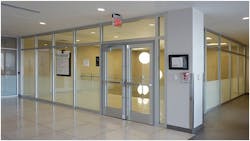Code change proposals aim to close more loopholes on uncontrolled radiant heat transmission
Since 2004, SAFTI FIRST has been writing articles aimed to educate building officials, designers, glazing contractors and the public on the two types of fire rated glazing products based on performance: fire protective, which meant it blocked smoke and flames only and met NFPA 252/257, and fire resistive, which meant it blocked smoke, flames and met the ASTM E-119/UL 263 wall test that limits radiant heat transfer to safe levels. At the same time, we continued to submit and support code changes that included the actual terms ‘fire protective (or fire-protection-rated)’ and ‘fire resistive (fire-resistance-rated)’ in the IBC Chapter 7 tables to make it clear where fire protective vs. fire resistive glazing were allowed or required. We also wanted the tables to clearly show the applications where fire protective glazing like ceramics and wired glass were limited in size or not allowed altogether because of its inability to limit radiant heat.
It is our belief at that time, as it is today, that the confusion has led to misapplications of ceramics in areas where ASTM E-119/UL 263 rated fire resistive glazing is required to protect building occupants from radiant heat. It is important to note that the changes we proposed in the 2012 IBC were not new provisions, but a clarification of code requirements that were in place since the 2006 IBC.
After much discussion and debate, the 2012 IBC was finally updated to include the helpful changes as mentioned above. In addition, that 2012 IBC managed to close an important loophole that allowed for uncontrolled radiant heat transmission through doors. In the 2006 and 2009 IBC, fire protective glazing like ceramics were allowed to exceed 100 sq. inches in the door vision panel in 60-90 minute doors in exit enclosures and exit passageways if the entire building was equipped with an automatic sprinkler system installed in accordance with Section 903.3.1.1 or 903.3.1.2.
This exception was removed in the 2012 IBC (and in the 2015 IBC). This means that for over 80% of the states that are either adopting the 2012 or 2015 IBC, fire protective glazing like ceramics are always limited to 100 sq. in. door vision panels in 60-90 minute doors in exit enclosures and exit passageways regardless is the building is fully sprinklered. In order to exceed the door vision panel size limitation, fire resistive glazing tested to ASTM E-119/UL 263 must be used.
Today, we continue the work of protecting the public from uncontrolled radiant heat by closing a few more loopholes in the code. Recently, we supported two code changes submitted by Davidson Code Concepts for the 2021 IBC. First is for open parking garages to meet the means of egress requirements in Chapter 10, in light of recent multi-vehicle fires. This code change would protect the stairways in these open garages in the event of a fire.
The second code change deals with Energy Storage System (ESS) installations. The proposal aims to require fire resistive glazing in ESS because the radiant heat exposure in a fire can create a thermal runway. The Fire Code Action Committee (FCAC) submitted a similar proposal that required a 2-hour separation. Clearly, radiant heat is an issue for this application.
We are happy that radiant heat as a safety issue has gained traction between building officials, designers, and the public. However, we feel that there is much work to be done, so we will continue to do our best in our educational outreach and product development to ensure the safety of building occupants.
About the Author

William O'Keeffe
About the Author: William O’Keeffe is the President and CEO of SAFTI FIRST Fire Rated Glazing Solutions, a leading USA-manufacturer of advanced fire rated glass and framing systems. An industry veteran and innovator with over 45 years of experience in architectural glazing, he was first to introduce and manufacture clear, fire resistive glazing products in the US. He is also a safety advocate who exposed the dangers of traditional wired glass, which lead to code changes and fire rated glass products that are safe, affordable and clear alternatives to traditional wired glass. Today, William continues to develop building products that enable architects to create beautiful, safe and energy-efficient spaces with advanced glazing systems.
